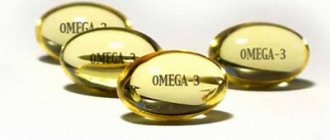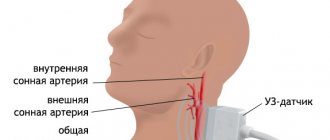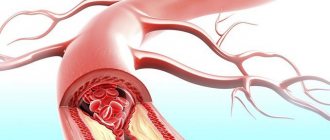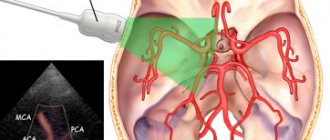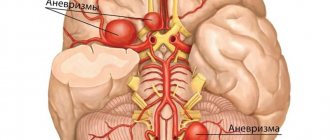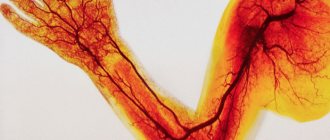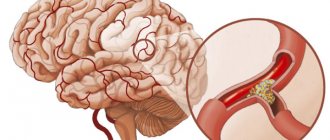Home » Heart diseases or cardiac diseases » Vascular tone disorders: regulation, hypertension, hypotension
August 22, 2020 No comments
Vascular tone disorders are divided into hypertensive and hypotonic conditions.
General recommendations
To understand what happens to blood vessels during VSD, you must first understand how the autonomic system works. It is the part of the nervous system responsible for heart rate, hormone production, blood pressure, respiratory system, and feelings of satiety or hunger. When the system malfunctions, the vessels are the first to suffer. Their tone decreases or, on the contrary, becomes excessive, which leads to pathological changes in the structure.
To strengthen blood vessels during VSD, you must first adjust your daily routine, your diet, reduce physical stress on the body (but go for a walk every day) and get rid of bad habits (smoking and regular drinking).
To regulate vascular tone, magnetic therapy, darsonvalization, and electrophoresis should be done. The specifics of the procedures and their systematicity should be selected by the attending physician.
Diets to strengthen blood vessels
The diet of patients with VSD is based on the principles of rational nutrition:
- providing the body with the necessary macro- and microelements: you need to include in the diet foods that contain the physiological norm of proteins, fats and carbohydrates;
- the presence in the menu of products that improve blood circulation and stabilize blood pressure;
- regular consumption of water (about 2 liters) to stabilize the water-salt balance.
A balanced diet is the answer to the question of how to increase vascular tone during VSD.
With the hypertensive type of vegetative-vascular dystonia, it is necessary to limit the consumption of salt and products containing it:
- cheese;
- sausage;
- smoked meats;
- pickles and so on.
The diet should be enriched with potassium and magnesium, since potassium promotes the excretion of water and sodium, and magnesium has vasodilating properties.
Sources of potassium:
- dried fruits;
- eggplant;
- cottage cheese;
- spinach;
- apples;
- honey.
Sources of magnesium:
- cereals;
- legumes;
- nuts;
- seeds;
- watermelons.
It is necessary to limit the consumption of fatty and fried foods, carbonated drinks and alcohol.
With VSD of the hypotonic type, the diet should contain various salted and fermented foods that bind water in the body and increase blood pressure.
You also need to include in the menu:
- butter;
- fatty meat and fish;
- cheeses;
- smoked meats
You should not give up drinking strong coffee, tea, chocolate and tonic drinks.
Folk remedies
There are many folk methods that are used to strengthen blood vessels:
- Mix chamomile, St. John's wort, immortelle, birch buds and yarrow in equal proportions. For the full course of treatment you will need 1 glass of dry raw materials of each medicinal plant. 1 tbsp. collection, pour 500 g of boiling water and leave for 2-3 hours. After this, the infusion is filtered, a little honey is added and taken 2 times a day - in the morning on an empty stomach and in the evening before bed. The course of treatment must be completed every 4 years. This product cleanses blood vessels and restores their elasticity.
- To strengthen blood vessels, you can take medicine made from garlic and cranberries. Take cranberries and garlic in equal proportions, grind using a meat grinder or blender and let it brew for 3 days. After this, the mixture must be thoroughly squeezed out. Add a little honey to the resulting juice (to improve taste) and take 1 tbsp before meals. 2 times a day.
- Take 5 walnut kernels, chop, add 1 tbsp. honey and leave for 1 day. This medicine should be taken 4 times a day, 1 tbsp. The course of treatment is 30 days. This cleaning of vessels is carried out 2 times a year.
Other recommendations not related to the use of medications:
- play sports: walking, running, swimming, but do not overdo it with the choice of load volume;
- take a contrast shower once a day and visit the bathhouse as often as possible;
- place a massage mat near the bed to improve blood circulation in the legs;
- learn to alternate work and rest.
How to strengthen blood vessels and improve blood circulation
The vascular system is the basis of human blood circulation. The health of blood vessels contributes to normal blood circulation, which is why it is so important to strengthen their walls. There are many ways to strengthen capillaries, including not only traditional medicine, but also regular physical exercise.
Why do you need to strengthen blood vessels?
All kinds of violations in their work carry a number of unpleasant consequences that manifest themselves slowly and insidiously. Therefore, often, a person does not pay due attention to them.
Our vessels initially have elastic tissue, but under the influence of certain factors it becomes rough and fragile, which prevents arteries and veins from expanding and contracting correctly. Such disorders entail improper blood circulation, and, as a result, stagnation of blood in organs and tissues.
To avoid this trouble, which tends to progress and interfere with a person’s life, it is necessary to strengthen the walls of blood vessels.
When do you need to strengthen blood vessels?
When disorders in the vascular system lead to obvious consequences, it is necessary to turn to treatment methods. The most common complaints doctors hear from patients are:
- dizziness;
- coldness in the extremities;
- numbness;
- pain in the arms and legs;
- short-term memory loss, absent-mindedness;
- speech disorder;
- changes on the skin of the extremities.
Important!
Since these symptoms indicate disturbances in the functioning of the vascular system, pay attention to your body. If you experience at least one of the symptoms listed, consult your doctor immediately.
How to strengthen the walls of blood vessels
Today, various treatment methods are used to treat vascular pathologies. A conservative approach using medications is considered the most effective, but folk remedies have no worse positive effects in the prevention and initial stages of vascular disease.
Preparations for strengthening blood vessels and capillaries
The most common medications for the treatment of diseases of the veins and blood vessels are:
- Troxerutin. Contains flavonoids. Isolated from plant components. It has an angioprotective effect, fights inflammation in the veins, and also increases their tone and elasticity.
- Diosmin. A flavonoid that fights the loss of vascular tone, stimulates blood circulation and strengthens the walls of blood vessels. Used in combination with hesperidin.
- Pentoxifylline. A drug that helps improve blood supply to blood vessels, increasing their resistance and flexibility. It also has the ability to deliver oxygen to organs and tissues.
- Mexidol. Contains ethylmethylhydroxypyridine succinate. Fights the fragility of blood vessels, helps deliver oxygen through the bloodstream to organs and tissues.
- Actovegin. It is used as a prophylactic for mild vascular pathologies, and is included in the treatment of more serious problems as a comprehensive additional remedy. Supplies the body with oxygen and improves blood circulation.
- Gingko biloba. Contained in many medicines, both independently and in combination. Improves the adaptation of blood vessels to changes in pressure and temperature. This improves memory and concentration.
It is important to know!
Using these drugs without consulting a doctor can cause unpleasant consequences and unwanted effects.
Folk remedies for strengthening blood vessels
Since ancient times they were used by our ancestors and received wide publicity. Even in the modern world they are often used, as they have no side effects and show decent results. Let's look at a few basic recipes widely used among people:
- walnuts. They have a positive effect on the blood vessels of the brain and heart, as they contain omega-3 fatty acids and vitamin E. To obtain results in the form of strong blood vessels and tissues, it is necessary to take a product made from nuts, honey and pineapple for two months. They are first crushed and mixed, then put in the refrigerator for a day. It is better to cook such a product for 2-3 days, then make a new portion, as the ingredients quickly deteriorate.
To treat atherosclerosis, walnuts must be chopped and filled with about a quarter of a glass jar (1 liter). Next, you need to fill the nuts with vodka to the top. This mixture needs to be infused for a month in a cool, dark place. Then take the infusion one tablespoon once a day, every day. This tincture improves blood circulation and will gradually cleanse blood vessels;
- pomegranate juice. Useful in the fight against atherosclerosis. It contains anthocyanins and antioxidants, which not only lower cholesterol levels, but also effectively fight cancer. By taking pomegranate juice daily, the blood vessels will gradually clear;
Important!
Pomegranate is an active source of iron and can increase hemoglobin. Before using the juice, make sure that this indicator in the blood is not too high.
- herbal tinctures for feet. It is no secret that herbs such as hawthorn, clover, bindweed have the ability to tone blood vessels. You can buy them in a ready-made pharmacy version in the form of tinctures or prepare them yourself.
To prepare hawthorn tincture, you need to chop 300 grams of berries and pour a glass of vodka over them. The infusion period is 3 weeks, then the tincture should be strained through gauze and taken 1 teaspoon in the morning and at night.
A tincture of field bindweed is prepared by mixing and infusing the herb and alcohol for a week at a ratio of 1:5. A week after preparation, it is necessary to filter the product and take a teaspoon twice a day for two weeks.
Meadow clover tincture is made from the flowers of the plant in the amount of two glasses and one liter of vodka. For two weeks, it is necessary to infuse the product in a cool, dark place, then filter and take one tablespoon twice a day for two months;
- parsley for the face. Spider veins or rosacea on the face cause weak capillaries. This does not look aesthetically pleasing, so it is better to start treatment without waiting for the problem to grow. Parsley infusion, which is rich in vitamin C and antioxidants, will help cope with this problem. It is prepared from chopped herbs in an amount of 10 grams, 100 ml of boiling water and one glass of milk. This infusion is not taken orally, but lotions are made on the site of rosacea using moistened gauze napkins. The procedure must be carried out daily, applying the resulting mixture for 20 minutes;
Interesting fact!
Many women use parsley frozen in ice. Such cubes with a useful plant are used for facial massage.
- rose hips to strengthen the blood vessels of the eyes. Rose hips must be brewed with boiling water at a rate of 1:10 and kept on low heat for 10 minutes. The prepared solution is used as a lotion on the area around the eyes daily, for about 15-20 minutes;
- yarrow juice to strengthen the capillaries in the nose. Yarrow is rich in vitamin K, which has a powerful hemostatic effect and therefore effectively fights nosebleeds. To use it correctly, you need to finely chop the raw material and squeeze the juice out of it with a spoon. This product should be instilled into the nose three times a day;
- herbal teas to increase the elasticity of blood vessels. The collection can be combined independently, if you know pharmacognosy, but a ready-made collection option is also offered. It is necessary to purchase barberry sprigs, Japanese Sophora grass, cudweed and clover leaves. This raw material is mixed and crushed in equal parts. Add a tablespoon of this dry product to 500 ml of boiling water and cook over low heat for 20 minutes. Next, the decoction is filtered and consumed 60 ml once a day every day. The course of treatment is one month.
Vitamins to strengthen blood vessels and capillaries
Some vitamins can strengthen and maintain the tone of blood vessels and capillaries. They are sold in pharmacies and do not pose a threat to the patient in the form of side effects. Pentovit vitamins, which contain B vitamins, will be excellent helpers in treatment. Their course of treatment takes 1 month if taken three times a day after meals.
Complex vitamins "Ascorutin" will help support blood vessels and capillaries throughout the body. The composition contains rutin and ascorbic acid. A complex of vitamins containing Omega 3-6-9 acids will help prevent the appearance of cholesterol plaques. The pharmacy assortment offers a wide range of such vitamins; it is enough to consult with a pharmacist about the selection of the drug.
Products for strengthening blood vessels
“You are what you eat” - this quote most accurately reflects the need for proper nutrition in order to avoid unpleasant consequences and diseases. To maintain blood vessels in good condition, you need to consume the following foods:
- nuts;
- legumes;
- porridge (buckwheat, rice, oatmeal);
- lean meat (beef, chicken, rabbit, horse meat);
- vegetables (spinach, greens, cucumbers, bell peppers, carrots, onions);
- fruits (oranges, grapefruit, bananas, apples, pears);
- oil (linseed, hemp, olive).
For drinks, you should give preference to green tea and herbs such as chamomile, yarrow, linden, currant, etc.
How to maintain blood vessels in normal condition
As mentioned earlier, to maintain veins in good shape, you need to take vitamins and infusions. However, physical activity plays an important role.
Gymnastics
You should perform the following exercises on a regular basis twice a day. In this way, you can not only support healthy blood vessels, but also restore weak ones.
- Bike. While lying on your back, you need to raise your legs and bend them at the knees. Imitating the movement as when riding a bicycle, move your legs for 3-5 minutes. Then you need to take a break for 1-2 minutes and repeat the exercise.
- Jumping rope. Suitable for people who do not suffer from heart disease, as there is a cardio load. There is no need to jump high; to do this, select a jump rope that suits your height. Perform 150 jumps, dividing them into three equal sets.
- Circular movements. Movements of the head and pelvis are used. You need to stand straight, feet shoulder-width apart, hands on your belt. Slowly, in a circular motion, turn your head first in one direction, then in the other. You need to make about 10 turns in both directions. Do the same with the pelvic area.
- Birch. Helps blood not to stagnate in the limbs. You need to stand in the birch tree pose for 2 minutes, then rest and repeat the exercise.
- Swing your arms and legs. Starting position: stand straight, arms along the body. On the count of “one”, swing one leg, while having time to clap your hands under the raised leg. On the count of two, return to the starting position. In total, you need to do ten swings, then move on to the exercise on the second leg.
Attention!
You should not exercise if you have heart disease.
Training for hypertension
People suffering from high blood pressure should exercise exercise with extreme caution. You can perform circular exercises on the head and pelvis and on the bicycle. Let's consider special exercises for hypertensive patients that do not pose a risk:
- Lunges. Standing straight, hands on your waist, lunge with one leg forward. Hold this position for 10 seconds, then return to the starting position and repeat the exercise with the other leg. You need to do 10 lunges.
- Fast walk. If you don't have a treadmill, you can imitate walking in place by raising your knees high. Perform approximately 300 steps, then restore your breathing for a minute and repeat the exercise.
- Wall push-ups. It is necessary to approach the wall, creating an angle between the floor and the body of approximately 45 degrees. Do 10 push-ups, then take a break and repeat the exercise.
Such light exercises, if performed regularly, will bring maximum benefit and support not only blood vessels, but also muscles.
Hardening
A great way to keep blood vessels in perfect condition. True, you need to approach this method with extreme caution. Start with a contrast shower. The temperature difference should not be too high initially. Change the water every 10 seconds.
After the first two weeks, you can create more contrast by increasingly increasing and decreasing the range of water temperatures. Pouring is also an effective method, but is suitable for a prepared body.
It is carried out daily in the morning, starting with cool water.
It is important to know!
Real walruses use ice water, but this is dangerous for an unprepared body.
How to strengthen blood vessels for a child
Hardening, taking vitamins, and sports are also used to strengthen children's blood vessels. You can send your child to swimming, where the results will not take long to arrive. Nutrition must be adjusted.
The diet should contain vitamins, plant components, protein, and oils. Walks in the fresh air should be daily and long. Also, to prevent vascular diseases, there is a children's massage mat that improves blood circulation.
It would be a good idea to attend massage sessions, which can improve blood circulation and nutrition.
https://www.youtube.com/watch?v=CgduyoUpgKk
You need to think about vascular health from a young age. By eating right, regularly doing physical activity and attending a massage, you can avoid many pathologies and even become a long-liver.
Source: https://sosud-ok.ru/sosudi/ukrepit-sosudy.html
Medicines and vitamins
To improve the condition of blood vessels, doctors recommend taking the following medications and vitamins:
- ascorbic acid (vitamin C) - strengthens capillaries;
- rutin (vitamin P) - reduces fragility;
- fat-soluble vitamin E - increases strength and improves the general condition of the body;
- Detralex - stabilizes the condition of capillary walls;
- statins (Atorvastatin) - partially flush cholesterol from artery walls and reduce atherosclerotic plaques;
- metabolic drugs (Piracetam, Cerebrolysin, Corvitin) - improve blood flow in the vessels of the brain;
- antihypertensive drugs (Bisoprolol, Lisinopril) - reduce blood pressure, indirectly strengthening the arteries.
- antithrombotic (acetylsalicylic acid) - prevent the formation of blood clots in the arteries.
These drugs significantly improve the condition of blood vessels. They are used both for prevention and in complex therapy.
Source: eutress.ru
Venotonic plants for the treatment of varicose veins
Normaven Last updated: 05/10/2020 What to do if spider veins begin to appear on your legs? read more
Chronic venous insufficiency is one of the most common vascular diseases.
According to statistics, up to 40% of the adult population of the planet suffers from it. CVI develops under the influence of changes in blood vessels that occur as a result of varicose veins. Both surgical and conservative methods are used to treat it.
The latter, among other things, includes herbal medicine - the use of herbs to improve the condition of arteries and veins.
How effective is this approach? Is it possible to return the tone of the venous wall to normal with the help of plant extracts, decoctions and tinctures? And what kind of herbs should you drink to strengthen veins with varicose veins? You will find answers to these questions below.
List of venotonic plants
What is the effect of herbs on veins with varicose veins? Herbal medicines have a number of advantages compared to pharmaceutical tablets. Firstly, they have a less herbal composition and are eliminated from the body faster without harming the detoxification systems, which include the liver and kidneys. Secondly, most of the ingredients for making homemade herbal remedies are low in cost. However, despite these advantages, herbs for the treatment of varicose veins have a significant drawback: they help mainly at the initial stage of the disease and should only be used in combination with other remedies. Venotonic plants for the treatment of varicose veins
Venotonic plants and herbs for thrombophlebitis and varicose veins
Good herbal remedies should accomplish one or more of the following:
- Thin the blood.
- Improve blood flow.
- Strengthen the walls of blood vessels.
- Help increase their elasticity.
Traditional medicine recipes used to treat varicose veins of the legs and thrombophlebitis include the following plants:
- Witch hazel. This wild shrub contains a large amount of flavonoids, which reduce the permeability of capillary walls and prevent their fragility, and also thin the blood.
- Horse chestnut. This plant is perhaps the most famous and common component in traditional medicine recipes for the treatment of varicose veins. This popularity is due to its decongestant, venotonic, anti-inflammatory properties. Chestnut flowers, seeds, leaves and fruits are used to prepare homemade ointments, tinctures and lotions.
Rose hips to strengthen blood vessels
- Rosehip and hawthorn fruits. The fruits of these plants contain bioflavonoids, ascorbic and chlorogenic acid. These substances help thin the blood and strengthen the walls of blood vessels.
- Cowberry. Lingonberry berries and leaves contain acids and flavonoids, which have a beneficial effect on the condition of capillaries and veins. This plant also has a diuretic effect, reducing high blood pressure.
- Arnica. The flowers and roots of this plant are used to treat varicose veins. Arnica contains substances that reduce the fragility and permeability of capillary walls, thereby reducing the severity of the venous pattern.
However, in large quantities this herb can lead to blood thickening, so arnica should be used strictly in doses.
- Pine bark. Pine tree bark contains flavonoids, antioxidants and phenolic acids, which reduce swelling and cramps. Used for preparing foot baths.
Pine bark baths for varicose veins
- Crassula. Money tree sap is used to prepare tinctures that are recommended for rubbing feet. This helps reduce inflammation and relieve swelling. However, you need to know that Crassula contains arsenic, so taking such infusions orally is contraindicated.
In order for herbal treatment for varicose veins of the legs to be effective and not cause harm to health, it is important to use high-quality raw materials. Herbs should be collected in environmentally friendly areas, with normal radiological background.
Many of the herbs we reviewed for varicose veins are part of external venotonics. One of them is Normaven® Foot Cream.
It contains herbal ingredients such as extracts of horse chestnut, green tea, ginkgo biloba, lingonberry, arnica and wormwood, as well as lemon oil.
Regular use of this remedy for 3 months helps to reduce spider veins on the legs, eliminate the feeling of heaviness, swelling and cramps.
What herbs should not be used for varicose veins?
Mechanics of regulating vascular tone in the body
Self-regulation of vascular tone is called autoregulation. The command to constrict or dilate blood vessels can be given by any of four reactions: muscular, metabolic, humoral and nervous.
Muscle tone regulation
The muscle (myogenic) reaction is intended to protect capillaries from hemodynamic overload and prevent disruption of transcapillary fluid exchange. So, with a sudden increase in blood pressure, myogenic protection is activated, which compresses the arteries. Precapillary resistance increases, and postcapillary resistance decreases, as a result of passive expansion of venous vessels by increased pressure.
When blood pressure decreases, opposite effects occur - a decrease in precapillary resistance of a myogenic nature and an increase (due to passive-elastic return of the veins) of postcapillary resistance.
Thus, myogenic vascular reactions maintain circulatory homeostasis in many physiological (physical activity, orthostasis), borderline (emotional stress) and pathological (hypo- and hypertension) conditions of the body, accompanied by changes in arterial and venous pressure.
Metabolic regulation of tone
Changes in the metabolic state of tissue can change vascular tone. The metabolic reaction monitors energy consumption in cells and their supply. Lack of oxygen, low pH or excess carbon dioxide instantly activates the vasodilation mechanism to carry out the necessary metabolic processes.
carbon dioxide has the most powerful effect on vascular tone . In most organs and tissues, an increase in CO2 in the blood (hypercapnia) causes blood vessels to dilate, and a decrease in CO2 (hypocapnia) causes them to narrow. Thus, the percentage of CO2 in arterial blood can serve as an indicator of the deterioration of blood supply to tissues in the human body.
For example, with active ventilation of the lungs, the level of CO2 in the blood drops and the brain vessels narrow. The narrowing can be so strong that it reduces cerebral blood flow by half, which can result in loss of consciousness, hallucinations and death of nerve cells from ischemic hypoxia. Read more about hyperventilation and CO2 here.
It is worth mentioning separately about oxygen , which the body needs every moment of life. If the need for it exceeds its supply, the breakdown product of ATP - adenosine - leaves the cells and has a strong relaxing effect on the smooth muscle cells of the arterioles.
the capillary network receives more oxygenated blood, the process of oxidative rephosphorylation of ATP again ensures sufficient resynthesis of ATP and the release of adenosine stops. [3] In this case, the oxygen level not only affects vascular tone, but also significantly weakens the constricting effect of catecholamines, angiotensin, and can inhibit the muscular response of blood vessels.
Also, changes in the lumen of blood vessels are affected by many other chemicals. For example, a slight increase in potassium ions in the blood causes blood vessels to dilate, while a high level of potassium ions narrows them. Calcium ions cause contraction, sodium and magnesium ions cause expansion, as do mercury and cadmium ions. Acetates and citrates cause vasodilation. Chlorides, biphosphates, sulfates, lactates, and nitrates have a significantly less effect. Ions of hydrochloric, nitric and other acids cause vasodilation.
Humoral regulation of vascular tone
Humoral regulation of vascular tone is called the action of tissue hormones. In contact with hormones, the endothelium produces substances that can change the tone of smooth muscle cells:
• Adrenaline, depending on the predominance of α-receptors, can have both an expanding and a contracting effect; • Bradykinin is capable of dramatically dilating blood vessels. AND.
otensinogen, which is converted to angiotensin II, which constricts blood vessels; • Atriopeptides have an expanding effect; • The influence of serotonin depends on the initial vascular tone: if it is high, it dilates the vessels and, conversely, with low tone, it acts as a vasoconstrictor; • Prostaglandins, thromboxane A and leukotriene B are also involved in regulating vascular tone.
Autonomic regulation of vascular tone
The autonomic nervous system regulates vascular tone with electrical nerve impulses by changing the frequency of cell excitation. An increase in impulse in the vasomotor nerves leads to contraction of blood vessels, and a decrease leads to their dilation. The expansion of the lumen of blood vessels in areas of the skin also occurs with mechanical or chemical irritation of the skin receptors of this area of the skin (axon reflex).
With an increase in anxiety and tension, a-adrenergic receptors of the sympathetic nervous system are excited, which strengthens and increases heart rate, constricts all blood vessels except the heart, brain, and lungs. At a frequency of nerve impulses of 10 per 1 sec, maximum narrowing is observed. Activation of β-adrenergic receptors of sympathetic nerve fibers, on the contrary, leads to vasodilation, but they are not present in all organs.
Normally, the vasomotor nerves have a slight effect on the tone of the vessels of the pulmonary circulation. Therefore, these vessels are dilated, and the resistance in the small circle is low, 10 times less than in the large circle. When the sympathetic nervous system is activated, the tone of the vessels of the small circle increases, which leads to an increase in venous return and to the transfer of blood from the small circle to the large circle.
During rest, sleep, eating or bathing, the parasympathetic part of the nervous system predominates, which weakens and slows heart contractions, dilates blood vessels and improves blood flow. It is this department that is responsible for dilating the blood vessels of the tongue, salivary gland, pia mater, and genital organs.
Any of the above factors can lead to disruption of autoregulation of vascular tone . As a result of the failure, vascular imbalance occurs: the vessels do not dilate enough or contract more. The transition of pressure beyond the lower limit of autoregulation leads to tissue ischemia (Fig. 2), beyond the upper limit - to tissue edema (Fig. 3).
Rice. 2. Tissue ischemia.
Rice. 3. Tissue swelling.
Source: thermalwater.com.ua
Hypertonicity of cerebral vessels
Vascular tone is the tension of the vascular walls maintained by the muscular wall in these vessels.
This is a factor that determines the blood supply to brain tissue. The tone of the muscle wall maintains a certain tension, allowing the lumen of the vessel to maintain the required diameter. Thanks to the muscular walls of the cerebral vessels, the brain tissue is protected from a lack or excess of blood, therefore, in a healthy body, the blood supply to the brain does not depend on pressure changes in other parts of the body.
However, with diseases of the internal organs or disorders of the nervous system, the tone of the arteries and veins may change: the muscle wall goes into a state of spasm - the lumen of the vessel decreases, and the supply of blood to the neurons decreases. This leads to tissue hypoxia, when the brain does not receive the proper amount of oxygen and nutrients. Vascular hypertonicity provokes functional and organic disorders in the brain.
What it is
Hypertonicity is a change in the tone of a vessel, in which the lumen of the latter decreases due to spasm of the smooth muscles of the arteries, and vice versa, if the tone decreases, this is called hypotonicity.
Increased tone can be of a physiological or pathological nature.
In the first variant, vascular tone naturally increases during temporary functional states, when a normal amount of adrenaline is released due to internal (pain, fear) and external (sharp loud sound) factors. Physiological hypertonicity will never lead to disorders in the long term and is considered a positive temporary condition.
Pathological hypertonicity of cerebral vessels is formed as a result of diseases of internal organs, glands and metabolic disorders. Severe arterial spasm can lead to ischemic stroke (acute cerebrovascular accident), which results in irreversible organic changes in tissue and subsequent loss of intellectual and motor capabilities.
Causes
The following reasons lead to spasm of cerebral arteries and veins, which are divided into psychological (neurological, psychiatric), somatic (bodily) and indirect.
Psychological reasons:
- Anxiety disorder, accompanied by excitement, fear due to constantly elevated levels of adrenaline.
- Vegetovascular dystonia. The disease is characterized by an imbalance between the functioning of the autonomic parts of the nervous system. In this disease, blood vessels spasm for no obvious reason.
- Stress, neuropsychic tension.
- Sleep disturbance: insomnia, taking a long time to fall asleep.
- Personality pathologies: psychopathy, accentuation. This is predominantly a hysterical, emotionally labile and cycloid personality type.
Somatic causes:
- Arterial hypertension - as a primary disease - a persistent increase in blood pressure over 140/80 for more than two weeks.
- Atherosclerosis is the presence of fatty deposits on the walls of the arteries.
- Inflammation of the walls of blood vessels.
- Diseases involving systems: rheumatoid arthritis, systemic lupus erythematosus or scleroderma.
- Diseases of the endocrine organs: pheochromocytoma is a tumor of the adrenal glands that sharply stimulates the glands and provokes the release of huge amounts of adrenaline.
- Dystrophic diseases of the musculoskeletal system: cervical osteochondrosis, spinal hernia.
- Hyperthyroidism. What it is? This is a disease of the thyroid gland, in which the release of T3-T4 hormones increases, which increases the sensitivity of blood vessels to adrenaline and norepinephrine.
- Inflammation of the tissue of the nerve ganglia of the sympathetic parts of the autonomic nervous system.
- In children, cerebral ischemia is observed due to pathologies during pregnancy and complicated childbirth. As a rule, a child’s pathology is diagnosed immediately in the maternity hospital.
Indirect reasons that increase the likelihood of hypertension:
- smoking;
- large doses of caffeine: more than three cups of coffee per day; caffeine temporarily stimulates the release of adrenaline into the blood;
- diabetes;
- heredity;
- age: from 50 years old, mostly men;
- prolonged stay in stuffy, unventilated rooms;
- weather sensitivity.
Symptoms
An increase in cerebral vascular tone refers to cerebral hypertonicity and the following symptoms develop:
- Headache in diffuse localization. The area of pain depends on the place where hypertonicity is most pronounced. Also, unpleasant sensations can spread throughout the entire head at once. The pain can spread to the neck, eyes, ears.
- Due to the deterioration of blood supply, intellectual and mnestic activity deteriorates: the pace of thinking slows down, the volume and concentration of attention decreases.
- Changes in physiological state: fatigue, exhaustion. Even simple work requires mental and physical effort.
- Emotional disorders: mood lability (sudden transitions from a bad mood to a good one and vice versa), irritability. Low threshold of excitability: quiet sounds and dim light can make a person angry.
- Nausea and vomiting.
- Hypertonicity, combined with difficulty in venous outflow, is manifested by a feeling of fullness in the head.
- Syncope is rarely observed in the clinical picture. However, especially sentimental people may faint from happiness.
Treatment
Complex therapy of the disease, how to restore brain function and how to increase the body’s performance:
- Treatment of the underlying illness that led to a disorder of brain tone.
- Psychohygiene: dosed mode of work and rest.
- Get a good night's sleep: remove bright light sources (phone, laptop) away from you an hour before bedtime.
- Aromatherapy. You can use scented sticks or scented oils.
- Balance your diet: reduce salt and alcohol intake.
- Drug treatment. Medicines that lower blood pressure: valerian, captopres or captopril.
- Folk remedies:
- rosehip tea;
- take a warm shower or bath.
The original article is posted here: //sortmozg.com/bez-rubriki/gipertonus-sosudov-golovnogo-mozga
Source: //zen.yandex.ru/media/id/5b55bb6e9d6d6f00aa31e8ef/5dc1223a2f1e4400af751644
Why is vascular tone needed?
With the help of vascular tone, the body regulates one of the main parameters - blood pressure. Its normal level ensures adequate nutrition of internal organs, including the myocardium and brain. How the vascular wall reacts to changes in the parameters of the internal and external environment determines a person’s well-being during changes in atmospheric pressure, increased physical activity, and the influence of stress factors.
In healthy people, especially with good training of the cardiovascular system, rapid expansion and contraction of the arteries occurs in response to stress, and then the vascular tone also quickly returns to normal. At the same time, all organs and tissues receive a sufficient amount of blood, which means oxygen and nutrients, metabolic processes are activated, and additional stress is easily tolerated.
The initial vascular tone is maintained by the work of smooth muscles. At the same time, the coronary arteries, vessels of skeletal muscles and kidneys have high tone, and the skin and mucous membranes are fed by arteries with low tone. When exposed to an intense stimulus, the high tone decreases and the low tone increases.
Your IP address is blocked.
Call time. Question: Hello! The fact is that for a year now my left eyelid and the left side of my face have drooped, I feel pain and pressure above my left eye. Recently my jaw began to hurt when I opened my mouth wide - again, on the left. The pupils are the same size. Could you comment on the situation taking into account these results: Rheoencephalogram The rheoencephalography data in this case is not very informative. A neurological examination is required, and additional examination will probably be required, the scope of which can only be determined during an in-person consultation. Make an appointment with a neurologist, phone
Regulation of cerebral blood flow includes a wide range of mechanisms aimed at maintaining optimal oxygenation and nutrition of the brain [12], and is characterized by pronounced autonomy from systemic regulatory factors [11].
WATCH THE VIDEO ON THE TOPIC: EXERCISES TO IMPROVE VASCULAR TONE OF THE HEAD AND NECK
Regulatory mechanisms
Control and maintenance of the necessary parameters of the lumen of the vessel is carried out by three mechanisms - local (autonomous regulation), nervous and humoral (through blood, tissue fluid).
Nervous
The tone of the vascular wall is directly influenced by impulses that come from the vasomotor center of the brain. It transmits a signal about the narrowing of the lumen of the arteries through sympathetic fibers, and about expansion through parasympathetic signals.
The second level (reflex) are the structures of the carotid sinus, aorta and pulmonary artery. They contain receptors that perceive blood pressure, its alkaline reaction, oxygen and carbon dioxide content. Through nerve fibers, information comes to the centers of the spinal cord. Due to this control link, blood flow is redistributed under stress conditions - vital organs receive an advantage in nutrition, even to the detriment of others.
More subtle regulation is carried out by the hypothalamus. It changes the activity of some parts of the autonomic fibers, inhibiting signals from others. This occurs due to the following mechanisms:
- Sympathetic nerves reduce the diameter of blood vessels in the skin, mucous membranes and digestive system, dilate coronary and cerebral arteries, pulmonary and skeletal muscles.
- Parasympathetic dilates the blood vessels of the tongue, glands of the oral cavity, choroid of the brain and genitals.
- Axon reflexes have a local vasodilator effect. An example is the redness of the skin when its receptors are irritated.
Humoral
At the local level, blood electrolytes regulate vascular tone - calcium and sodium constrict blood vessels and increase blood pressure, while potassium and magnesium have the opposite effect. Autonomous regulators also include:
- metabolic products (carbon dioxide, organic acids, hydrogen ions) accelerate the transmission of impulses to the brain, constrict blood vessels;
- histamine, bradykinin and prostaglandins reduce tone;
- serotonin, enzymes of the endothelium (inner lining) have a vasoconstrictor effect.
Systemic regulation of vascular tone is carried out by hormones secreted by endocrine glands:
- adrenaline and norepinephrine constrict all arteries except the brain, kidney and skeletal muscles;
- vasopressin reduces the lumen of veins, and angiotensin 2 arteries and arterioles;
- adrenal corticosteroids and thyroxine gradually increase vascular tone due to sympathetic impulses.
Local
This is the reaction of the vessel to two main parameters - pressure and blood flow rate. At high pressure, smooth muscle fibers are stretched, which causes their reflex contraction and increased resistance . When the pressure in the arteries decreases, the wall relaxes and does not interfere with the flow of blood. These processes do not require the participation of the brain.
Violation of local regulation can occur with a lack of oxygen, blood loss, dehydration, and low physical activity.
Vessel blockage
What affects vascular tone
Any change in the internal or external environment affects the activity of the cardiovascular system. The most common causes of significant fluctuations in vascular tone are:
- decrease or increase in atmospheric pressure, climate change;
- genetic characteristics of the nervous system reaction;
- stressful situations;
- infectious diseases;
- poisoning with chemical compounds, medications, alcohol or nicotine;
- skull injuries;
- atherosclerosis;
- diabetes;
- thyroid diseases;
- imbalance of sex hormones;
- obesity;
- low physical activity.
What will violations tell you about (decrease, increase)
Fluctuations in vascular tone are normal reactions to changes in the internal and external environment. Painful conditions occur only with a persistent increase or decrease.
Low tone - hypotension
There is a decrease in blood pressure below 100/60 mmHg. Art. In this case, the general weak tone cannot be compensated by a local increase in the resistance of arterioles or capillaries.
Typical clinical manifestations are:
- general weakness,
- fast fatiguability,
- headache,
- dizziness,
- fainting states,
- heartache.
The causes of persistent hypotension may be congenital asthenia, low activity of the adrenal glands, thyroid gland, and pituitary gland . A decrease in pressure is observed with exhaustion, prolonged infection, and intoxication. The most severe conditions occur with shock or collapse, which accompany injuries, burns, anaphylactic reactions, and acute heart failure.
Watch the video about hypotension, its causes and treatment:
Hypertension
The mechanism of high arterial wall resistance in old age is most often associated with sclerotic changes and loss of vascular elasticity. At a younger age, vascular spasm plays a major role. It occurs when regulation on the part of the central nervous system or humoral link is disturbed. Most often there are changes in the activity of the vasomotor center.
Under the influence of long-term stress factors, the brain is overstrained, a persistent zone of excitation appears, which sends a constant stream of vasoconstrictor impulses to the arteries. The vascular response to irritation increases and sometimes becomes distorted.
A secondary increase in vascular tone occurs in the following diseases:
- glomerulo- and pyelonephritis,
- compression of kidney vessels,
- disruption of the endocrine glands,
- polio,
- tumors and hemorrhages in the brain.
Blood pressure – hypertension and hypotension
An increase in vascular tone leads to a decrease in the diameter of arteries, veins and capillaries. The narrowing of the lumen of peripheral vessels leads to excessive stress on the heart muscle, increased blood pressure (BP), and deterioration of tissue nutrition due to decreased blood flow in the organs.
Very important (and first) indicators of blood vessel tone include systolic blood pressure (normal 110 – 130 mm Hg, daily fluctuations – 30 mm Hg), the values of which, in turn, are determined by:
- Left ventricular (LV) stroke volume;
- The highest rate of expulsion of blood from the left ventricle;
- The ability of the aorta to stretch.
As for diastolic blood pressure (normal 60 – 90 mm Hg, daily fluctuations – 10 mm Hg), its level is largely determined by:
- BCC (circulating blood volume);
- Tone of arterial vessels of the muscular type.
The stroke volume of the left ventricle does not play such an important role in the formation of diastolic blood pressure.
A decrease in vascular tone is indicated if the first beat is recorded at 90 or lower, and the last one drops below 60 mm. Hg Art. This is hypotension or hypotension. Its cause is often the failure of autonomic nervous activity, which is required to participate in the regulation of vascular tone. In such cases, blood flows slowly through the peripheral vessels and cannot reach the vessels of the head in a timely manner and in full to supply the brain with nutrition. Very often, the activity of the ANS and the tone of blood vessels do not keep pace with the growth of the body in adolescents. A decrease in vascular tone in children with or without NCD often has clinical manifestations of fainting, so orthostatic collapse in adolescents is not considered such a rare phenomenon.
How to increase or decrease vascular tone
To normalize vascular tone, the following recommendations must be followed:
- exercise regularly, cardio exercises are especially useful - walking, running, swimming;
- have enough time to sleep;
- carry out contrasting water procedures;
- adhere to a diet and a healthy diet.
If there are diseases in which vascular tone is impaired, they must be treated by a specialist; self-medication in such cases can lead to fatal consequences.
Vascular tone reflects the state of regulatory mechanisms of the nervous system and endocrine organs . Its level is affected by all changes in the internal and external environment. In a healthy person, increases and decreases occur within physiological limits. The speed of return to initial parameters shows the level of fitness of the cardiovascular system.
In pathological conditions, the tone is increased (hypertension) or decreased (hypotension). Normalization of vascular resistance is carried out in the form of therapy for the underlying disease.
Source: CardioBook.ru
Additional Methods
The clinical manifestation of VSD and the state of the vascular system of the brain largely depend on nutrition. To reduce the severity of symptoms of the disease, it is recommended to include foods that improve vascular tone in the diet:
fatty fish: it stimulates brain function;
- grape. It is an excellent natural antioxidant. In addition, this product improves short-term memory;
- cabbage: it is rich in vitamins and folic acid;
- lingonberries, blueberries. These berries increase the elasticity of blood vessels and stabilize blood pressure;
- olive oil, grapefruit, avocado - prevent the development of atherosclerosis;
- soy sauce – restores damaged blood vessels;
- apples (especially useful for high blood pressure);
- garlic – thins the blood, stimulates blood circulation;
- nuts.
You need to eat in small portions, 5-6 times a day: eating large amounts of food negatively affects blood circulation and increases the likelihood of developing vascular pathologies due to dystonia.
It is also important to maintain normal fluid intake: for normal functioning, the body requires at least 1.5 liters of water per day.
Physical activity is one of the components of successful treatment of vascular dystonia. Thanks to training:
- the functioning of the lungs and heart improves;
- vascular tone is normalized;
- blood supply to the brain increases;
- the functions of the nervous system are restored.
The condition of blood vessels has a positive effect: running, jumping rope, cycling, swimming and exercise in the gym. Also useful are team sports (volleyball, tennis, basketball), daily morning exercises, yoga and fitness. It is better to avoid exercises that require fast movements or lifting heavy loads - this can lead to deterioration in well-being.
Another effective way to train the blood vessels of the brain with dystonia is a contrast shower after waking up or before going to bed. It not only helps strengthen the vascular system, but also energizes you for the whole day, relieves stress and tension. But you need to take a contrast shower correctly, following the following recommendations:
- The procedure should begin with warm water.
- Then you need to slowly adjust the temperature to hot.
- After a few minutes, gradually turn the water in the shower cold, until it reaches ice cold.
Going to a bathhouse or sauna is beneficial for the vascular system. But whether it is possible to attend such procedures for VSD depends on the type of disease and general well-being. These procedures are strictly prohibited during the period of exacerbation of pathology.
